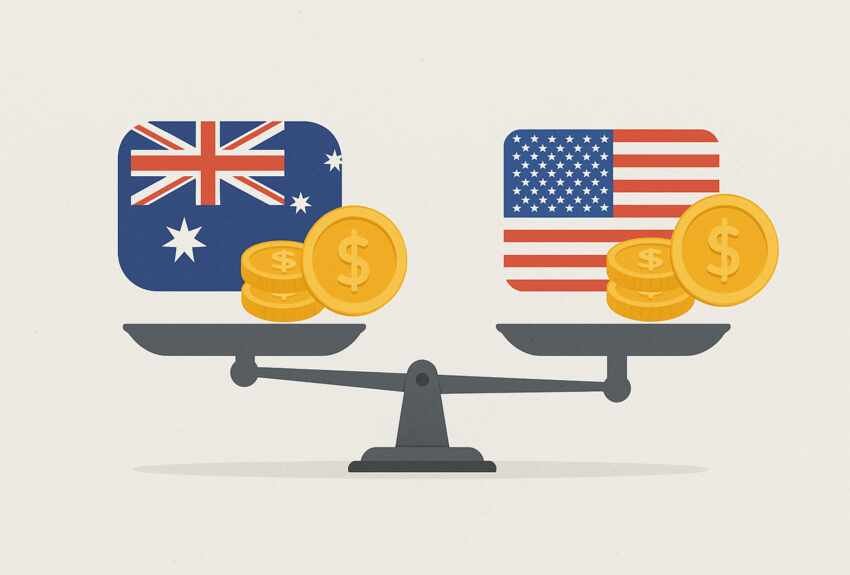
When choosing a destination to study or settle, the cost of living plays a significant role in decision-making. For international students, comparing the cost of living in Australia vs US is critical to understand where their lifestyle, budget, and educational goals align best. Both countries offer unique experiences, world-class universities, and opportunities, but the expenses can vary widely depending on location, lifestyle, and individual needs.
This article provides an in-depth comparison of living costs between these two countries, breaking down essentials like accommodation, food, transportation, and healthcare to help you make an informed choice.
Cost of Living Overview: Australia vs USA
The table below provides an approximate comparison of key living expenses in Australia and the US to give you a quick snapshot:
| Expense Category | Australia (AUD) | United States (USD) |
| Accommodation (Monthly) | $1,200–$2,000 | $1,000–$2,500 |
| Food and Groceries (Monthly) | $350–$500 | $400–$600 |
| Transportation (Monthly) | $100–$200 | $120–$250 |
| Utilities (Electricity, Internet) | $200–$300 | $150–$250 |
| Health Insurance (Annual) | $500–$700 | $1,000–$2,000 |
| University Tuition (Annual) | $20,000–$45,000 | $25,000–$50,000 |
Accommodation Costs
Australia:
Rent is one of the highest expenses in Australia, especially in cities like Sydney and Melbourne. Students usually opt for shared apartments, on-campus dormitories, or homestays to save money. In smaller cities like Adelaide or Brisbane, housing is comparatively affordable.
- Average rent for a shared apartment: $1,200–$1,800 per month.
- On-campus housing: Around $1,000–$1,500 monthly, often including utilities.
USA:
The US has a wide range of accommodation options depending on the city. Larger metropolitan areas such as New York and Los Angeles are significantly pricier than smaller towns or university-centric cities like Austin or Ann Arbor.
- Shared housing: $1,000–$2,000 per month, depending on the state.
- Dormitories: Usually $800–$1,200 monthly, excluding meal plans.
Food and Groceries
Australia:
Grocery costs in Australia are moderate, but dining out can be expensive. Students often shop at local markets or cook at home to save money.
- Weekly grocery bill: $80–$120.
- Eating out: $15–$25 per meal.
USA:
Groceries in the US are affordable in most states, especially if you buy in bulk or shop at discount stores like Walmart. However, dining out regularly can add up quickly.
- Weekly grocery bill: $100–$150.
- Dining out: $12–$20 per meal, higher in big cities.
Transportation
Australia:
Public transport is reliable and widely used by students in major cities. Buses, trains, and trams are common modes of travel, with student discounts available.
- Monthly public transport pass: $100–$150.
- Biking and walking are popular, especially in student-friendly cities like Melbourne.
USA:
The US transportation system varies significantly by city. Larger cities like New York and Chicago have excellent public transit, while smaller towns may require a car.
- Monthly public transit pass: $100–$150.
- Gas prices: Around $3.50 per gallon (varies by state).
Utilities and Internet
Australia:
Utility costs, including electricity, water, and internet, are manageable when split among roommates.
- Utilities (electricity, water): $150–$250 per month.
- Internet: Around $50–$80 per month.
USA:
Utility costs in the US are slightly lower than in Australia, but internet and mobile phone services can be more expensive.
- Utilities (electricity, water): $100–$200 per month.
- Internet: $60–$100 per month.
Healthcare
Australia:
Australia’s healthcare system is more affordable for students due to mandatory health insurance, which is a requirement for all international students under the Overseas Student Health Cover (OSHC) program.
- Annual health insurance: $500–$700.
USA:
Healthcare in the US is expensive, and international students must purchase health insurance, which can range from basic coverage to more comprehensive plans.
- Annual health insurance: $1,000–$2,000.
Education Costs
Australia:
Tuition fees for international students depend on the course and university. Australia’s universities are globally recognized for their high-quality education, particularly in fields like engineering, medicine, and business.
- Tuition fees: $20,000–$45,000 annually for undergraduate courses.
USA:
The US is known for its Ivy League and top-ranked universities. However, tuition fees can be higher compared to Australia, especially for private institutions.
- Tuition fees: $25,000–$50,000 annually, varying by program.
Key Factors to Decide Between Australia and the USA
- Budget:
Australia is generally more affordable for healthcare and transportation. However, the US offers a wider range of housing options that could fit smaller budgets. - Job Opportunities:
Both countries provide part-time work options for students, but the US has a broader job market with high-paying internships. - Lifestyle:
Australia offers a relaxed lifestyle with stunning beaches and outdoor activities. The US, on the other hand, is ideal for those seeking a fast-paced environment. - Proximity to Home:
If you’re from Asia, Australia is closer and may reduce travel expenses.
Which Country is Right for You?
The choice between Australia and the US depends on your priorities. If you prefer an affordable, laid-back lifestyle with excellent healthcare, Australia might be the better fit. On the other hand, if career opportunities and a dynamic environment are your focus, the US could be more suitable.
Final Thoughts
Comparing the cost of living in Australia vs US is essential for international students to make informed decisions. Consider factors like accommodation, tuition fees, healthcare, and daily expenses before choosing.
Remember, both countries offer excellent educational opportunities and diverse cultural experiences. No matter where you decide to go, plan your finances carefully and enjoy the adventure of a lifetime!
